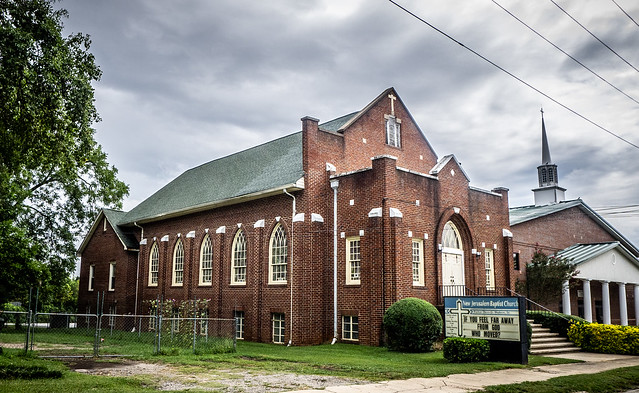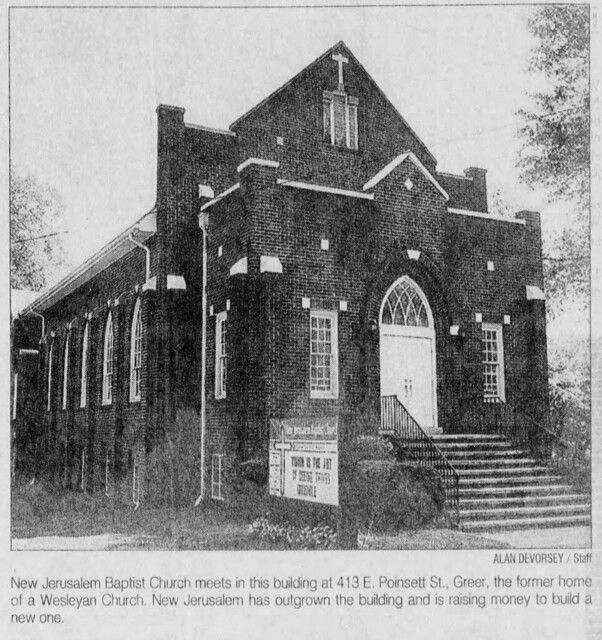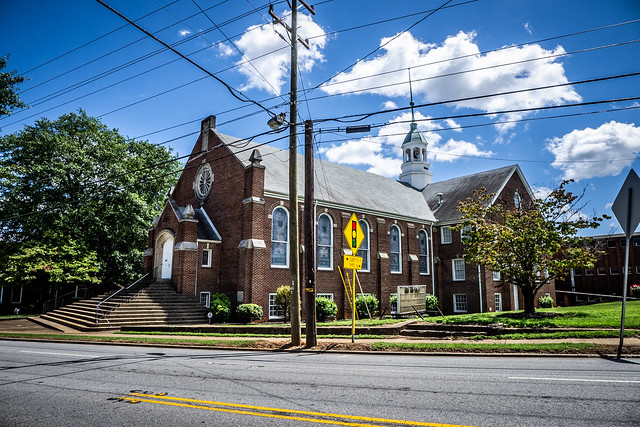Non-Oeland Churches and Conclusions
I was really looking for a consistent architectural style from the Oelands, but it’s just not there. Many of their churches have the capped ornamentations and keystones, but I don’t know if that’s the architect’s preference or the taste of the congregation. I’m guessing it’s a combination. I’ve come across many churches in the area with similar features that I know are not Oeland churches.
Judson Baptist Church has these Gothic features. Its cornerstone indicates that it was designed by the firm Pickell and Pickell. The church is now known as Greater Mount Carmel Baptist Church.
Liberty Hill Methodist Church is another of these. I found an article stating when the church was built in 1956, but no mention of the contractor or architect.

The former Bible Presbyterian Church on August Road, now Paramount Park Baptist, also has the Gothic features, but I don’t think it’s an Oeland church.

Whoever designed the Greer Church of God seems to have gotten carried away with the white-capped ornaments. I’d be very surprised if this were an Oeland church.

Finally, the old sanctuary for New Jerusalem Baptist Church in Greer has many of the same features. However, I find no record that the Oelands designed any churches for African-American congregations.

During the period in which these churches were constructed African American church news just didn’t make the social and religion columns like their white counterparts, so even if the Oelands had built an African American church, it’s unlikely it would have be reported.
However, New Jerusalem was originally owned by a white congregation, First Wesleyan Church of Greer, as indicated in this 1999 photo from The Greenville News.

A 2001 news article says that Rev. Steve Watson, who founded New Jerusalem, first rented, then purchased the building from the Wesleyans, whose congregation had dwindle down to only 10 or 12 members. Even so, I still have no indication that this was an Oeland church.
As for the Baptist churches built by the Oelands, they seem to be of the generic Southern Baptist mold, and could have been built by just about anyone. I guess that was the congregation’s preferred style, to “look Baptist.”
I still have unanswered questions. The Oelands don’t have a distinctive enough architectural style so that I can see a church and immediately say, “Oo! That’s an Oeland church!” Neither have I learned whether or not the McCarter design was exclusive to the Oelands or from some plan book. I’m hoping someone might still have the answers.
Regardless, it was interesting to learn about the Oeland church construction dynasty. The Oelands have contributed much to the religious community of the region and were community leaders. The only way to learn the true extent of their work would be to do painstaking research through company records, permits, and library archives, and I’m just not up for that. Even though their work is now being replaced with larger and more modern facilities, every time I stumble onto a brick church tucked back into some mill village, I’ll always wonder if it was designed and built by Oeland and Sons.

Enjoyed this article. Have read your writings before but had lost contact for awhile. I found this very interesting since my husband built churches in the area over the last 52 years. (M.L. Garrett Const. Co.) He closed the business two years ago but during those 52 years he built approximately 300 churches in the upstate. He does not “mess” with a computer so I ran him a hard copy of this article.
Now that I have discovered you and your adventures again, I am going back and catch up on your travels around the state.
According to this booklet https://lib.digitalnc.org/record/11916/files/ncimages_019210_000007.pdf , Oeland’s specialty was churches and he built over 100 of them. This item is unpaginated. The Oeland information is on the second page of the “The Early Years 1936-1959” section.
Good day! I love that you did this research – my husband is the great grandson of Paul Oeland and this means so much to have these details!! We are both native Greenvillians and his grandmother (daughter of Paul) lived in North Main Street for many decades as my husband was growing up and spending time with his grandmother. He doesn’t have a lot of information about his great grandfather (as his mother passed away sadly in 2005) so we are piecing together some lineage including the Oeland Simpson Lumber company which is now the Sawmill that Larkins operates. Paul Oeland owned that as well. Any more information you come across, I’d love to know! Many thanks!!
Hi! Which Paul Oeland are you referring to?
What was his grandmother’s name? I am the daughter of Paul Jr and Bennie Oeland. Paul Sr and Aileen were my paternal grandparents.
Thanks for this history. Paul J. Oeland was my great uncle. His sister, Louise, was my grandmother.